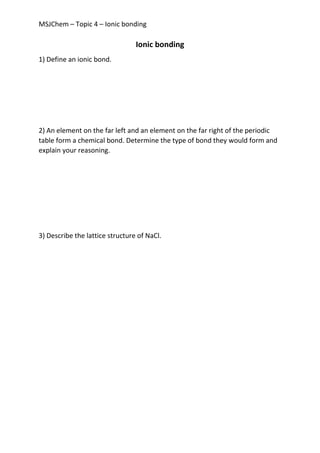Report
Share
Download to read offline

Recommended
More Related Content
What's hot
What's hot (20)
10/26 What are the 3 types of chemical bonds? - Part II

10/26 What are the 3 types of chemical bonds? - Part II
Similar to topic_4_ionic_bonding.pdf
Similar to topic_4_ionic_bonding.pdf (20)
Recently uploaded
Recently uploaded (20)
Costs to heap leach gold ore tailings in Karamoja region of Uganda

Costs to heap leach gold ore tailings in Karamoja region of Uganda
POST TRANSCRIPTIONAL GENE SILENCING-AN INTRODUCTION.pptx

POST TRANSCRIPTIONAL GENE SILENCING-AN INTRODUCTION.pptx
Soil and Water Conservation Engineering (SWCE) is a specialized field of stud...

Soil and Water Conservation Engineering (SWCE) is a specialized field of stud...
Adaptive Restore algorithm & importance Monte Carlo

Adaptive Restore algorithm & importance Monte Carlo
Abortion uae unmarried price +27791653574 Contact Us Dubai Abu Dhabi Sharjah ...

Abortion uae unmarried price +27791653574 Contact Us Dubai Abu Dhabi Sharjah ...
Mining Activity and Investment Opportunity in Myanmar.pptx

Mining Activity and Investment Opportunity in Myanmar.pptx
GBSN - Microbiology (Unit 7) Microbiology in Everyday Life

GBSN - Microbiology (Unit 7) Microbiology in Everyday Life
Factor Causing low production and physiology of mamary Gland

Factor Causing low production and physiology of mamary Gland
Quantifying Artificial Intelligence and What Comes Next!

Quantifying Artificial Intelligence and What Comes Next!
Information science research with large language models: between science and ...

Information science research with large language models: between science and ...
GBSN - Microbiology (Unit 6) Human and Microbial interaction

GBSN - Microbiology (Unit 6) Human and Microbial interaction
topic_4_ionic_bonding.pdf
- 1. MSJChem – Topic 4 – Ionic bonding Ionic bonding 1) Define an ionic bond. 2) An element on the far left and an element on the far right of the periodic table form a chemical bond. Determine the type of bond they would form and explain your reasoning. 3) Describe the lattice structure of NaCl.
- 2. MSJChem – Topic 4 – Ionic bonding Answers: 1) An ionic bond is the electrostatic attraction between oppositely charged ions. 2) An element on the far left is likely to be a metal, an element on the far right is likely to be a non-metal. Metals and non-metals on opposite ends of the periodic table have a big difference in electronegativity (1.8 units or greater), therefore they form an ionic bond. 3) The sodium and chloride ions are held together by their opposite charges (+ and -). Each sodium ion is surrounded by six chloride ions. Each chloride ion is surrounded by six sodium ions.